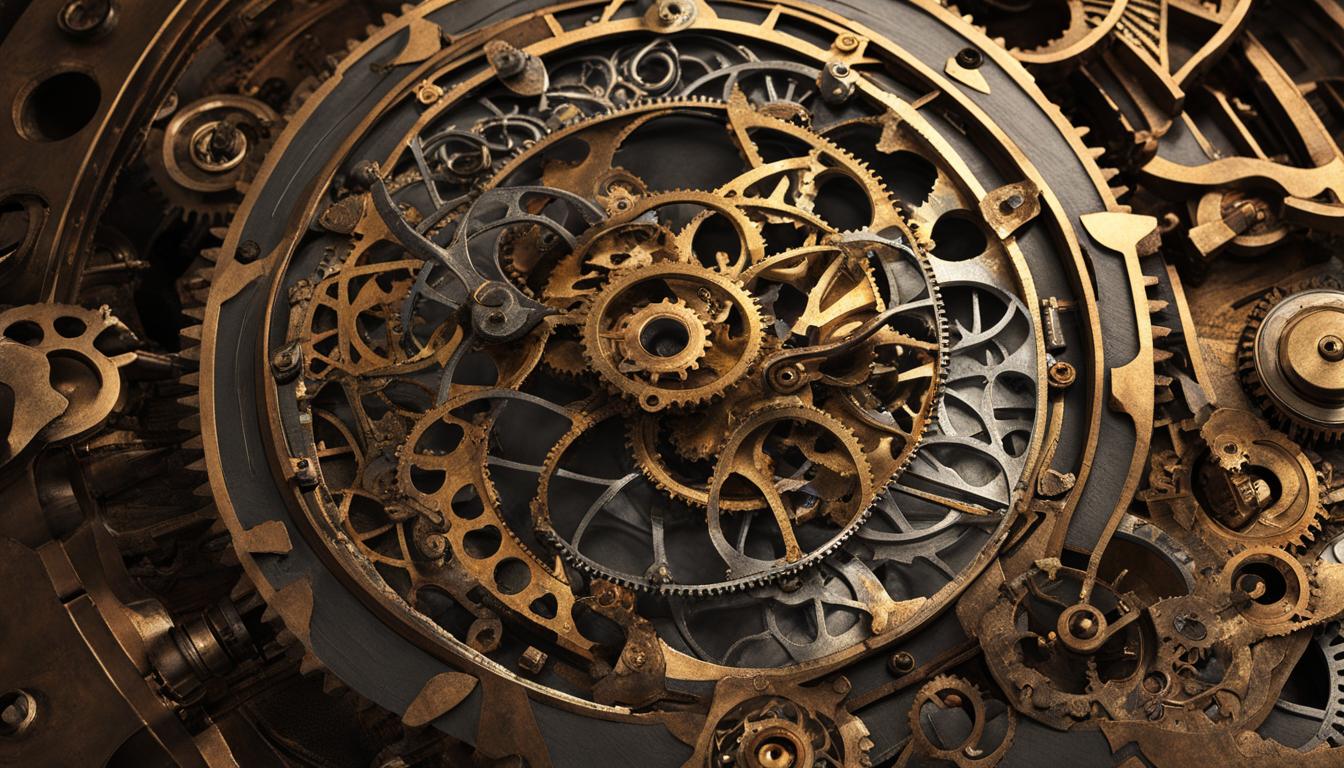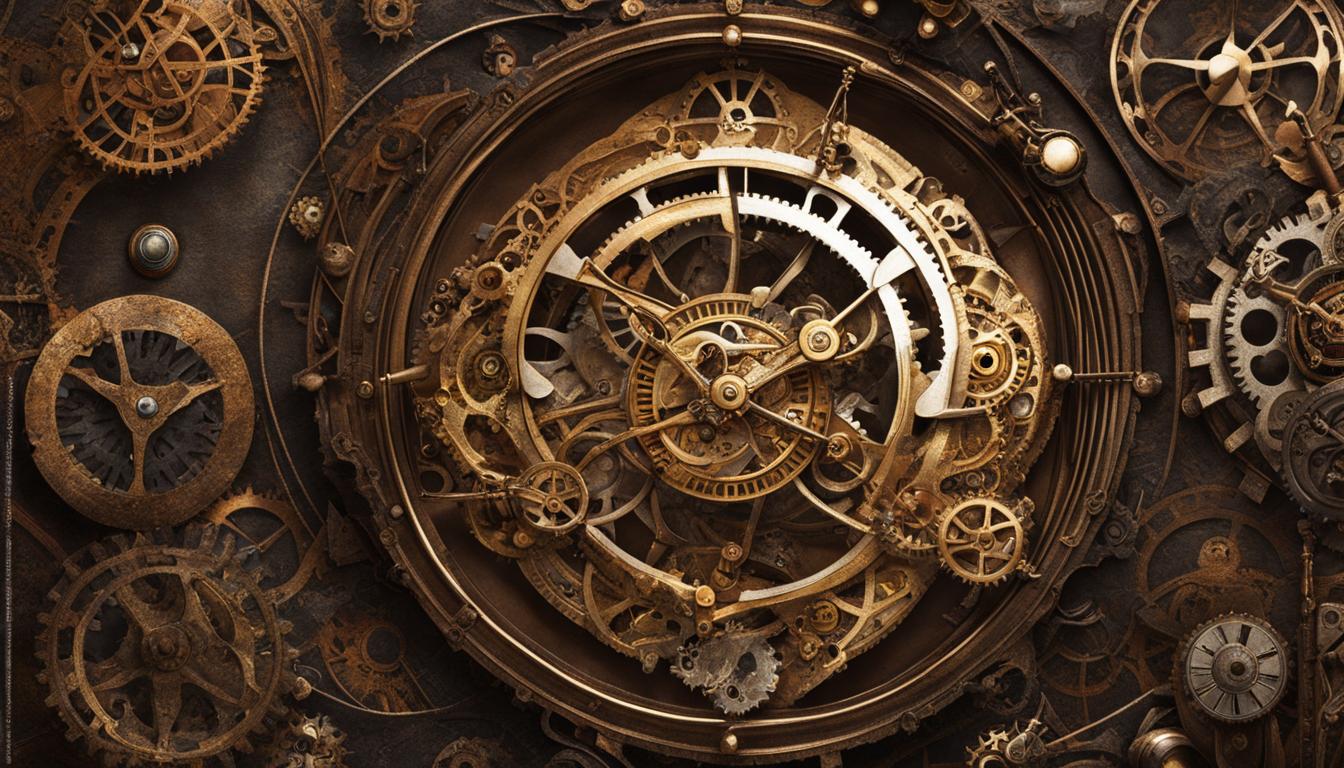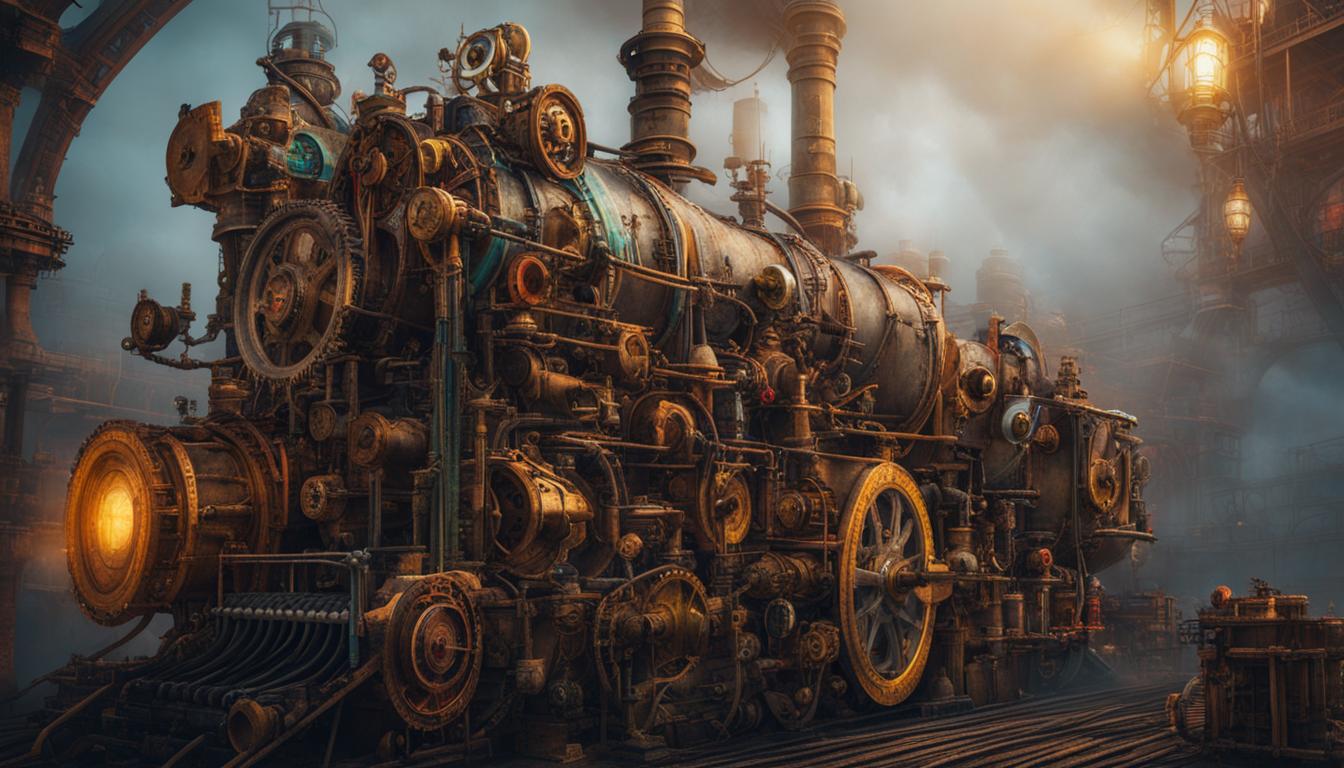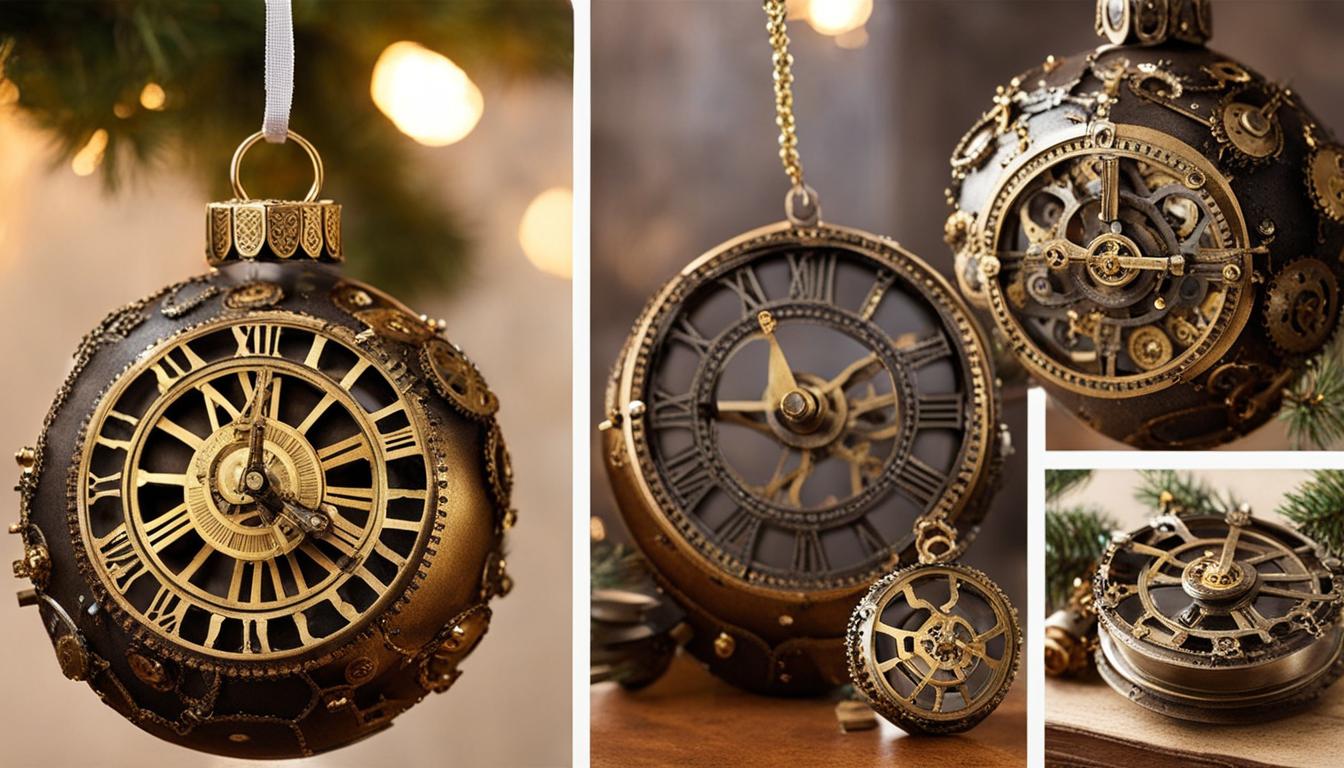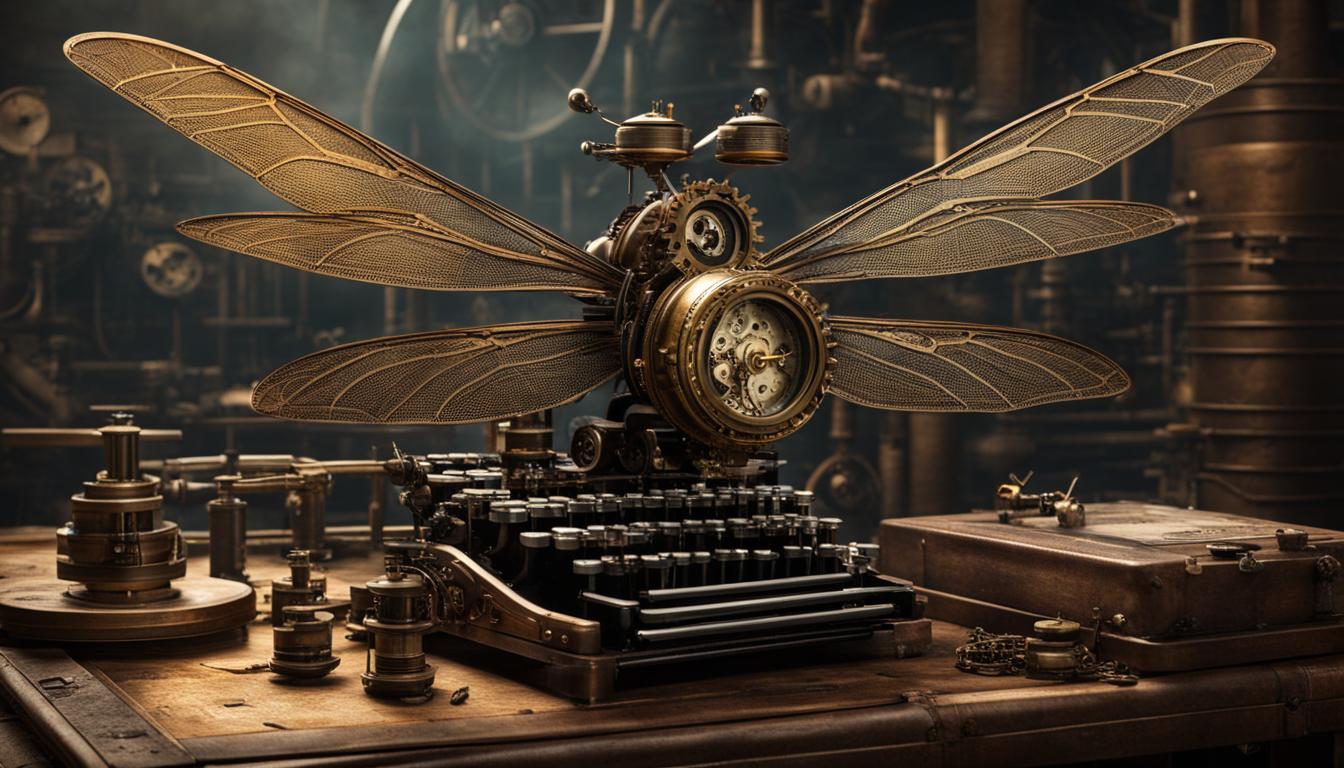Steampunk design is a mesmerizing blend of historical elegance and futuristic innovation, where the past meets the future in an enchanting dance of gears and imagination. To truly push the boundaries of creativity in steampunk DIY projects, one must embark on a journey of discovery, diving deep into the essence of this unique aesthetic.
Embracing the mechanical elements that define steampunk, such as gears, cogs, and levers, is essential. The strategic use of metals like copper and brass adds a touch of authenticity and industrial charm. But it doesn’t stop there – steampunk is about reimagining history and breathing new life into vintage items, creating designs that defy convention and ignite the imagination.
Key Takeaways:
- Studying the distinctive aesthetic of steampunk is essential for pushing creative limits in DIY projects.
- Seek inspiration from historical eras, including the Victorian era and the Industrial Revolution, to infuse authenticity into your designs.
- Analog design elements like gears, cogs, and clocks are crucial for capturing the essence of steampunk.
- Experiment with textures and patterns, combining wood and metal textures for a striking contrast.
- Incorporate iconic symbols such as gears, cogs, and timepieces to add depth and character to your steampunk creations.
Inspiration in Historical Eras
Steampunk design draws inspiration from rich historical eras, taking elements from the Victorian era and the Industrial Revolution. By exploring these periods, designers can discover a treasure trove of ideas to incorporate into their steampunk creations. From fashion to architecture to technology, every aspect of these historical eras offers unique insights and possibilities.
Looking beyond Europe provides even more inspiration for steampunk design. The American Wild West, with its rugged landscapes and pioneer spirit, can bring a sense of adventure to steampunk projects. Feudal Japan, with its intricate armor and elegant design, adds a touch of exoticism. By blending elements from different historical eras, designers can create their own narratives and push the boundaries of steampunk design.
“Steampunk design allows us to re-imagine history and create new worlds where the past collides with the future,” says renowned steampunk artist, Amelia Wells. “By delving into different historical eras, we can unlock a wealth of inspiration and bring our imagination to life.”
Table: Historical Eras and their Steampunk Inspirations
| Historical Era | Inspiration for Steampunk Design |
|---|---|
| Victorian Era | Victorian fashion, architecture, steam-powered machinery |
| Industrial Revolution | Gears, cogs, clocks, mechanical innovations |
| American Wild West | Rugged landscapes, pioneer spirit, frontier technology |
| Feudal Japan | Intricate armor, elegant design, samurai aesthetic |
By immersing themselves in historical eras and taking inspiration from diverse sources, designers can infuse their steampunk projects with authenticity and originality. The possibilities are endless, and the only limit is one’s imagination.
Using Analog Design Elements
Steampunk design is all about embracing the analog. From gears and cogs to steam machines and hand-drawn illustrations, these elements bring a sense of nostalgia and authenticity to steampunk creations. By incorporating analog design elements, creators can capture the essence of the Industrial Revolution and create visually stunning and unique designs.
Embracing Gears and Cogs
Gears and cogs are the heart and soul of steampunk design. Their intricate patterns and mechanical functionality evoke a sense of innovation and industry. These elements can be used to create both functional and decorative aspects of steampunk designs. For instance, a table lamp can feature gears and cogs as the base, giving it a distinct steampunk aesthetic. Alternatively, gears and cogs can be incorporated into jewelry, such as pendants or earrings, adding a touch of steampunk charm to any outfit.
Add a Personalized Touch with Steam Machines and Hand-Drawn Illustrations
In addition to gears and cogs, steam machines and hand-drawn illustrations are key elements that can elevate steampunk designs. Steam machines, such as steam engines or pressure gauges, can be used as decorative focal points or functional pieces within a design. Hand-drawn illustrations, on the other hand, add a personalized and unique touch. They can be incorporated into artwork, clothing, or even as wall decals to create a truly immersive steampunk experience.
Integrating Analog Design Elements into Overall Designs
The key to using analog design elements effectively is finding innovative ways to incorporate them into the overall design. These elements shouldn’t feel like an afterthought but should seamlessly blend with other components. For example, gears and cogs can be integrated into furniture designs, such as tables or cabinets, where they serve both as decorative features and functional components. By thoughtfully integrating analog design elements, creators can bring their steampunk creations to life.
| Analog Design Elements | Examples |
|---|---|
| Gears and Cogs | Table lamps, jewelry, clothing accessories |
| Steam Machines | Decorative focal points, functional pieces |
| Hand-Drawn Illustrations | Artwork, clothing, wall decals |
Experimenting with Textures and Patterns
Steampunk design is all about embracing textures and patterns that bring depth and character to your creations. By combining wood and metal textures, you can create a striking contrast between the rough, industrial feel and the warm, natural counterbalance. Imagine the intricate details of a wooden gear mechanism intertwined with the gleam of polished brass. This juxtaposition not only adds visual interest but also captures the essence of steampunk aesthetics.
To further enrich your designs, consider incorporating a variety of patterns. Geometric designs, such as intricate clockwork patterns or interlocking gears, can add a sense of precision and order to your steampunk creations. Victorian-era motifs, like ornate floral designs or delicate lace patterns, can infuse elegance and nostalgia into your designs. And for that extra touch of authenticity, experiment with grungy textures to create an aged, worn-out look commonly found in steampunk. Layering these textures and patterns will give your designs complexity and richness, taking them to the next level.
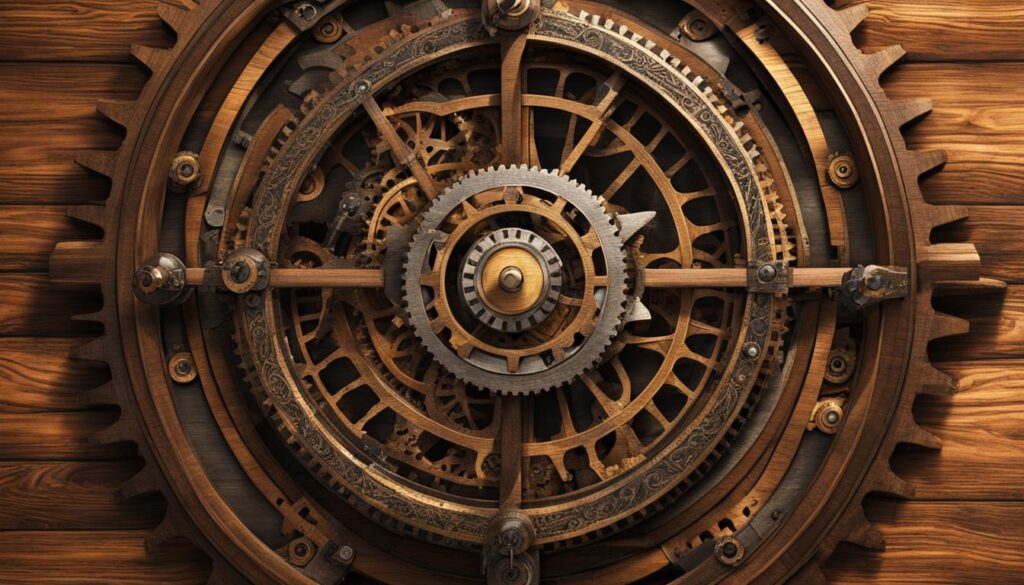
Incorporating textures and patterns in your steampunk designs not only adds visual appeal but also tells a story. Each texture and pattern choice contributes to the overall narrative and helps bring the world of steampunk to life. So, let your imagination run wild as you explore the endless possibilities of combining different textures, patterns, and materials in your creations.
Incorporating Steampunk Icons and Symbols
Steampunk design is defined by its iconic symbols, which serve as visual markers of the genre’s unique aesthetic. Gears and cogs, with their mechanical precision and industrial charm, are the quintessential elements of steampunk. These symbols can be incorporated into designs as decorative accents, adding a touch of authenticity and creating a captivating visual appeal. Whether used as intricate embellishments or as central focal points, gears and cogs bring a sense of mechanical wonder and evoke the spirit of the Industrial Revolution.
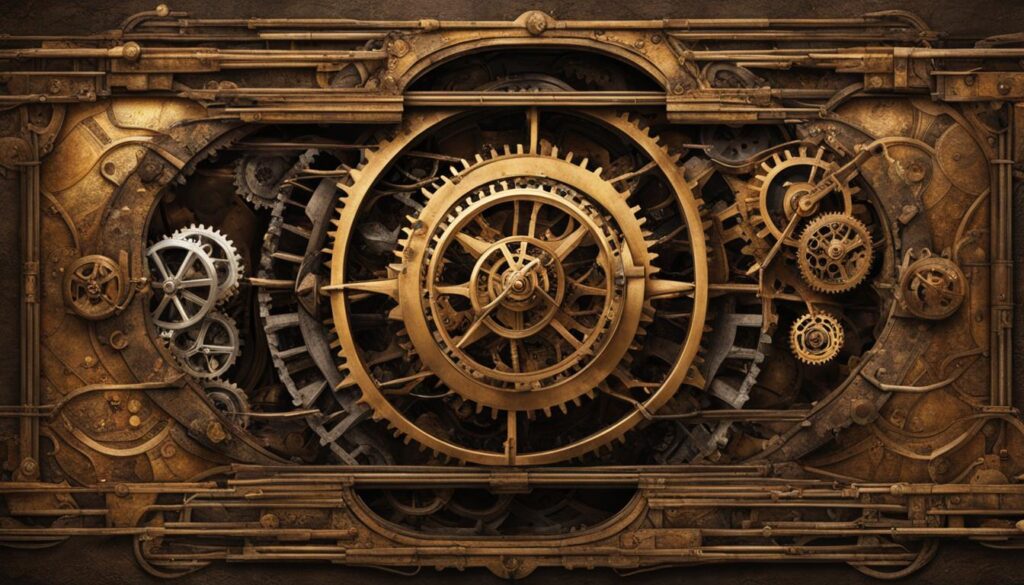
Another symbol closely associated with steampunk is the timepiece. Clocks and pocket watches, often featuring intricate details and ornate designs, represent the passage of time and serve as reminders of the Victorian era’s fascination with precision and measurement. These timepieces can be showcased in various ways, from adorning jewelry and accessories to being incorporated into larger steampunk installations.
Victorian fashion icons, such as top hats and corsets, also play a significant role in steampunk design. These elements add a touch of elegance and historical authenticity to steampunk creations. Whether it’s a stylish top hat adorned with gears or a corset-inspired bodice, these fashion symbols contribute to the overall aesthetic and help transport the viewer into the world of steampunk.
Table: Steampunk Icons and Symbols
| Symbol | Description |
|---|---|
| Gears and Cogs | Mechanical elements representing industrial innovation |
| Timepieces | Clocks and pocket watches symbolizing the passage of time |
| Top Hats and Corsets | Victorian fashion icons adding elegance and authenticity |
| Steam-Powered Machinery | Steam engines and airships creating a sense of adventure |
“Gears and cogs are the heart and soul of steampunk design, embodying the spirit of mechanical wonder and innovation.” – Steampunk enthusiast
By incorporating these steampunk icons and symbols into their designs, creators can capture the true essence of this unique genre. These elements bring authenticity, historical references, and a touch of mystery to steampunk DIY projects, allowing for endless possibilities and creative exploration.
Playing with Color Palettes
Color palettes are an essential aspect of creating captivating steampunk designs. Steampunk aesthetics typically embrace warm, earthy tones that evoke a sense of nostalgia and adventure. Deep browns, ambers, and aged brass are the foundation of a classic steampunk color palette. However, it’s crucial to venture beyond the expected and experiment with mixing in other colors to add a fresh spin to your designs.
Consider combining brass and sapphire for a luxurious and regal look, or charcoal and gold for a sophisticated and mysterious atmosphere. Teal and copper can create a striking contrast, while burgundy and cream offer a refined and elegant touch. The key is to find the right balance between the warm, earthy tones and the accent colors, ensuring they harmonize and enhance the overall steampunk aesthetic.
Remember, steampunk design is all about pushing creative boundaries and embracing unconventional ideas. Don’t be afraid to step outside the expected color schemes and explore new possibilities. Let your imagination run wild as you play with various color palettes to create unique and captivating steampunk designs.
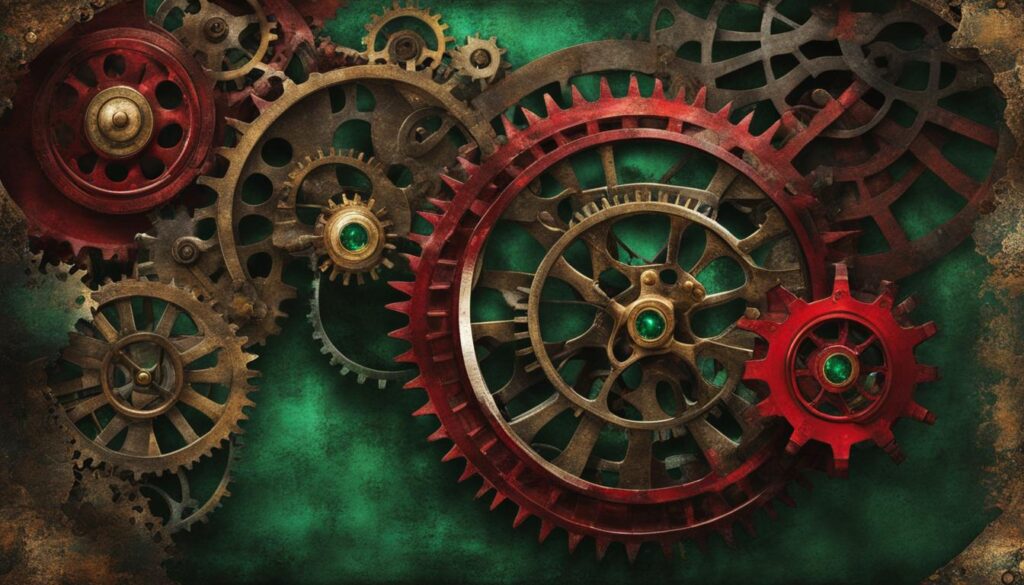
Table: Steampunk Color Palettes
| Color Palette | Description |
|---|---|
| Deep Browns and Ambers | A classic steampunk palette representing the warmth of aged wood and brass. |
| Brass and Sapphire | A luxurious combination that adds a touch of elegance and richness to steampunk designs. |
| Charcoal and Gold | Creates a mysterious and sophisticated atmosphere with a hint of glamour. |
| Teal and Copper | A contrasting palette that adds depth and visual interest to steampunk designs. |
| Burgundy and Cream | A refined and elegant color combination that exudes timeless charm. |
Conclusion
Steampunk design is a fascinating realm of creative exploration in crafts that can truly ignite your imagination. By delving into the distinctive aesthetic, seeking inspiration from historical eras, and incorporating analog design elements, you can embark on unconventional steampunk projects that push the boundaries of creativity.
One of the key aspects of steampunk is attention to detail and playing with textures, patterns, and colors. Experimenting with grungy textures, combining wood and metal, and playing with warm earthy tones can add depth and character to your designs. Incorporating steampunk icons and symbols like gears, clocks, and Victorian fashion can bring authenticity and a sense of adventure.
But don’t be afraid to think outside the box and embrace unconventional steampunk project ideas. Let your creativity soar as you reimagine history, blend the elegance of the Victorian era with futuristic innovation, and create unique narratives. With steampunk, there are no limits to what you can achieve.
FAQ
What is steampunk design?
Steampunk design is a unique blend of historical elegance and futuristic innovation, characterized by a fusion of Victorian elegance and industrial-era machinery.
How can I delve into steampunk design?
To delve into steampunk design, it is essential to study its distinctive aesthetic, including understanding the importance of mechanical elements, such as gears, cogs, and levers, as well as the use of metals like copper and brass. Embracing vintage items and reimagining history are also key factors in creating standout steampunk designs.
What historical eras can inspire steampunk designs?
Steampunk design is deeply rooted in history, particularly the Victorian era and the Industrial Revolution. Researching these historical eras, including fashion, architecture, and technology, can provide valuable inspiration for steampunk designs. Exploring beyond Europe, such as looking at the American Wild West or feudal Japan, can also offer unique elements to incorporate.
What are some key analog design elements in steampunk?
Analog design elements such as gears, cogs, and clocks represent the Industrial Revolution and are essential in creating a steampunk look. Other analog elements like steam machines and hand-drawn illustrations can add a personalized touch to designs.
How can textures and patterns enhance steampunk designs?
Textures and patterns play a vital role in creating depth and setting the mood in steampunk designs. Combining wood and metal textures can create a striking contrast, while geometric patterns, floral designs, and Victorian-era motifs add elegance. Grungy textures can provide an aged, worn-out look commonly found in steampunk.
What are some iconic symbols in steampunk design?
Gears and cogs, timepieces like clocks and pocket watches, Victorian fashion, and steam-powered machinery are iconic symbols in steampunk design. Incorporating these symbols is crucial for capturing the essence of steampunk.
What colors are commonly used in steampunk designs?
Steampunk design leans towards warm, earthy tones such as deep browns, ambers, and aged brass. However, there is room for experimentation and the incorporation of other colors to add a fresh spin to designs.
How can I push the limits of creativity in steampunk DIY projects?
By studying the steampunk aesthetic, seeking inspiration in historical eras, incorporating analog design elements, experimenting with textures and patterns, incorporating iconic symbols, playing with color palettes, and focusing on detail and depth, creators can push the limits of creativity in steampunk DIY projects. Embracing unconventional ideas and thinking outside the box can lead to truly unique and innovative steampunk designs.

